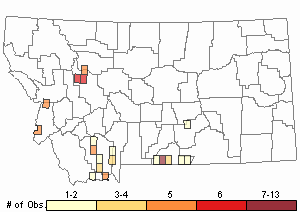View in other NatureServe Network Field Guides
NatureServe
Montana
Utah
Wyoming
Idaho
Wisconsin
British Columbia
South Carolina
Yukon
California
New York
Henderson's Wavewing - Cymopterus hendersonii
Other Names:
Pteryxia hendersonii
State Rank Reason (see State Rank above)
Cymopterus hendersonii is currently known in Montana from four locations in the Bitterroot Range of Ravalli Co. and one location in the Madison Range, one location in the Gravelly Range and one location in the Ruby Range, all in Madison Co. All known populations are from high elevations.
Cymopterus hendersonii was described from a collection made by Louis Henderson in east-central Idaho in 1895 (Coulter and Rose 1900). Subsequent treatments of the genus have placed similar plants from south-central Montana to Utah and Colorado into C. hendersonii (Mathias and Constance 1944-45, Cronquist 1961). However, Ronald Hartman has determined that the former plants are different from C. hendersonii and should rightly be called C. longilobus. True Cymopterus hendersonii is known from Madison and Ravalli counties in Montana (R. Hartman, personal communication) and east-central Idaho. Cronquist (1961) reported that the Henderson collection was made in Custer Co., but Love (2003) indicates it was from Lemhi Co.
General Description
Henderson's waferparsnip is a low, mat-forming perennial herb with a branched root crown covered in old leaf petioles. The petiolate leaves are all basal, 2-9 cm long and twice divided into well-separated, narrow segments. Herbage is glabrous or slightly roughened. The naked stems are 1-8 cm high, lax or erect. Small yellow flowers are born in a compound umbel subtended by 0-7 linear bracts. Each ultimate umbel is subtended by 3-7 narrow bracts, longer than the flowers. Fruits are elliptic, 2.5-5 mm long with 8 thickened, longitudinal wings protruding up to 1 mm above the surface.
Phenology
Flowering occurs in July and August.
Diagnostic Characteristics
Cymopterus nivalis (=C. bipinnatus) has white flowers and more membranous wings on the fruits. Cymopterus longilobus is a larger plant with most stems greater than 8 cm high. Cymopterus terebinthinus has short-hairy herbage.
Species Range
Montana Range
Range Descriptions

 Native
Native
Observations in Montana Natural Heritage Program Database
Number of Observations: 81
(Click on the following maps and charts to see full sized version)
Map Help and Descriptions
Relative Density

Recency



 (Observations spanning multiple months or years are excluded from time charts)
(Observations spanning multiple months or years are excluded from time charts)
Habitat
Cymopterus hendersonii occurs in dry talus or skeletal soil of upper slopes and ridge crests at 2620-3000 m (8,600- 9600 ft.) in elevation. Associated vegetation is sparse and dominated by cushion plants. The plant is associated with limestone in Madison Co. and with granite or metamorphic parent material in Ravalli Co.
Ecology
Cymopterus hendersonii is a small plant and occupies habitats with sparse vegetation
suggesting that it is not tolerant of competition.
Ravalli Co. populations all occur in the Selway-Bitterroot Wilderness. The Madison Range population also occurs in a wilderness area. The populations in the Ruby and Gravelly ranges are subject to livestock grazing; however, it is unlikely that these small forbs are palatable, and the sparsely vegetated habitat is probably not frequented by livestock.
Stewardship Responsibility
References
- Additional ReferencesLegend:
 View Online Publication
View Online Publication
Do you know of a citation we're missing? Culver, D.R. 1994. Floristic analysis of the Centennial Region, Montana. M.Sc. Thesis. Montana State University, Bozeman. 199 pp.
Culver, D.R. 1994. Floristic analysis of the Centennial Region, Montana. M.Sc. Thesis. Montana State University, Bozeman. 199 pp. Lesica, P., M.T. Lavin, and P.F. Stickney. 2012. Manual of Montana Vascular Plants. Fort Worth, TX: BRIT Press. viii + 771 p.
Lesica, P., M.T. Lavin, and P.F. Stickney. 2012. Manual of Montana Vascular Plants. Fort Worth, TX: BRIT Press. viii + 771 p. Lesica, P., M.T. Lavin, and P.F. Stickney. 2022. Manual of Montana Vascular Plants, Second Edition. Fort Worth, TX: BRIT Press. viii + 779 p.
Lesica, P., M.T. Lavin, and P.F. Stickney. 2022. Manual of Montana Vascular Plants, Second Edition. Fort Worth, TX: BRIT Press. viii + 779 p. Simanonok, M. 2018. Plant-pollinator network assembly after wildfire. Ph.D. Dissertation. Bozeman, MT: Montana State University. 123 p.
Simanonok, M. 2018. Plant-pollinator network assembly after wildfire. Ph.D. Dissertation. Bozeman, MT: Montana State University. 123 p. Simanonok, M.P. and L.A. Burkle. 2019. Nesting success of wood-cavity-nesting bees declines with increasing time since wildfire. Ecology and Evolution 9:12436-12445.
Simanonok, M.P. and L.A. Burkle. 2019. Nesting success of wood-cavity-nesting bees declines with increasing time since wildfire. Ecology and Evolution 9:12436-12445.
- Web Search Engines for Articles on "Henderson's Wavewing"





